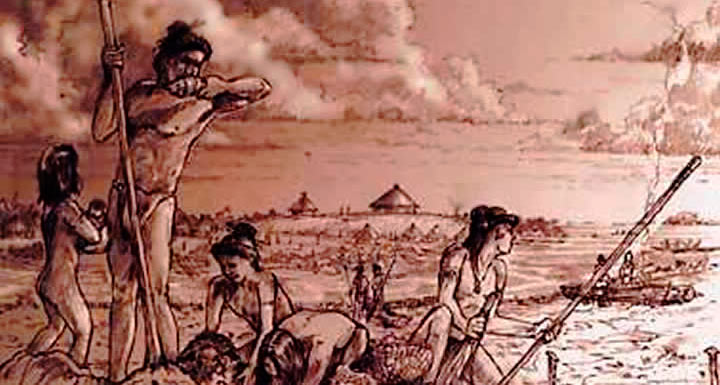
Miami in reverse
Everything morphed, returning to the previous condition. The mud became mud again, leaving an empty lot where the house had stood.
Alejo Carpentier, ‘Return to the seed’
MIAMI.- Let us imagine for a few minutes that Miami is still not Miami. It still hasn’t become a young, fashionable city that just marked its 118th birthday. Famous architects like Norman Foster, Richard Meier or John Pawson still have not designed gigantic buildings named after them. The city still has not attracted millionaires like Oprah Winfrey, Julio Iglesias, Ricky Martin, Shakira, or the Kardashians, who come here to tan themselves on its beaches, get drunk in its bars, and build estates in the form of mansions.
Let us suppose that the first apocalyptic ecologist who predicted its inevitable sinking has not yet been born, that David Beckham has not begun to look for a little corner where he can build his modest soccer stadium, that nobody has begun to mourn over LeBron James’ departure, that Marlins Park remains an empty lot.
Let’s go a little further back, before us Cubans arrived in waves in the 2000s, the 1990s, the ’80s, the ’70s, the ’60s. When the first son of an immigrant had not yet been born. When there was no such thing as the Versailles Restaurant in Little Havana, or the domino park on Calle Ocho, or the graffiti in Overtown, or the lemon trees in Little Haiti.
Long before Griselda Blanco, the Godmother, the alleged mentor of Pablo Escobar, organized — in the late ’70s and early ’80s — the routes for the distribution of cocaine through Miami. Before the Great Depression. Before the 1926 hurricane. Before George Merrick, a successful farmer and mediocre poet, designed the first Spanish-style homes in Coral Gables. Before William and Mary Brickell, along with their neighbor, Julia Tuttle, officially incorporated the city on July 28, 1896.
Before Henry Flager inaugurated the Florida East Coast Railway, which connected Miami to the rest of the country. Before Fort Dallas became the largest bastion against the Seminole Indians. Before Pedro Menéndez de Avilés funded St. Augustine. Even before Juan Ponce de León landed for the first time on the shores of Florida.
In other words, when this place was just a swamp, almost as full of alligators and mosquitoes as it is now.
Very near the heart of downtown, where today rise the Brickell buildings, was the capital of the Tequesta Indians, the first inhabitants of Florida, whose settlements go back 1,700 and 2,000 years. As it often happens in these cases, nobody has the slightest idea of how they got there.
The Tequestas knew nothing about agriculture. They fished, hunted, gathered fruits, killed mosquitoes and fought with other tribes, especially the Calusa, their arch-rivals.
Their customs were very similar to ours. During one season of the year — three months in which the mosquitoes became unbearable — they vacationed in the Keys, drank a concoction called “cassina” that made them vomit in abundance and, when their chieftains dies, buried the smallest bones and placed the biggest ones in a box for the tribe to worship as if they were gods.
When they found the Tequesta, the Spaniards spread the rumor that they performed human sacrifices, but the Spaniards saw cannibals everywhere. In any case, Hernando de Escalante Fontaneda, after shipwrecking near the coast of Florida, lived for 17 years among them and they never showed any intention of eating him or offering him to the gods.
What caught Escalante’s attention was the fact that the Tequestas hunted the Caribbean sea wolf — a species similar to the seal, apparently now extinct — but its meat was reserved for the higher classes, you know, the chieftain, the shaman, the model for cave-wall paintings.
The settlement in Brickell — some 24 holes on a rock, making a perfect circle known as the Miami Circle — was discovered in 1998, when millionaire Michael Baumann demolished an apartment building to build a condominium.
When he realized that his swimming pool would sit on the remains of the capital of the Tequesta, Baumann proposed to remove the site and send it with all due respect to a place where it might be less obtrusive. But several activists, from archeologists to children hooked on Indiana Jones movies, staged protests and Baumann had to respect the site.
He did so, however, after demanding from the state of Florida a $50 million indemnity, a figure that later — in an act of infinite charity — he lowered to $26.7 million. In an unprecedented action, the state paid that sum, using its funds and several donations.
The site turned out to be the oldest known settlement on the entire East Coast. In it were found artifacts made with leading technology (for the period): tools made of sea shells, axe heads cut from stone, coal for fire. Also found were several human teeth. As usual, scientists do not agree, but everything seems to indicate that the place was built for religious purposes.
After 1763, when the English took over Florida, Bernard Romans, who explored the area again all the way to the mouth of the Miami River, said that he had seen several hamlets but no inhabitants. Almost all the Indians had died. Those who weren’t killed by Spanish weapons were decimated by European diseases: syphilis and the common cold.
The few Tequesta who survived, left in the Spanish ships. And do you know where those Indians ended up? Irony of history — on the island of Cuba.

